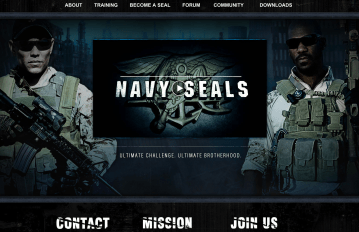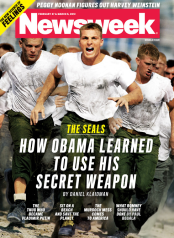The homepage of the SEALs' recruiting website
In nature, most seals are black, with relatively few white ones. The Navy’s SEALs have exactly the opposite problem – they’re overwhelmingly white, with hardly any blacks. So they’re trying to do something about it.
It’s a fundamental challenge in a democracy with an all-volunteer force: recruits may be drawn from all segments of society, but elite military units – and none is more elite these days than the SEALs, following their dispatch of Osama bin Laden last May – tend to draw from small pools of talent. For the SEALs, that includes athletic young men who are smart and good in the water. For whatever reason, that has led to an overwhelmingly white SEAL force.
Say the SEALs:
Gaps exist in minority representation in both officer and enlisted ranks for Special Warfare operators. Diverse officers represent only ten percent of the officer pool (for example, African Americans represent less than 2% of SEAL officers). Diverse enlisted SEALs account for less than twenty percent of the total SEAL enlisted population. Naval Special Warfare is committed to fielding a force that represents the demographics of the nation it serves. This contract initiative seeks effective strategies to introduce high potential candidates from diverse backgrounds to the opportunities available in Naval Special Warfare.
The SEALs are considering hiring help to attract thousands of “minority males in the 16–24 year-old target age range” to become SEALs. “This contract will create a mechanism to enhance Naval Special Warfare’s ability to conduct outreach, raise awareness, mentor, and increase self-selection to a career as a SEAL within minority communities,” a recently-posted draft contract solicitation says.
The Navy isn’t seeking only black SEALs: “Challenges for minority recruitment also exist in the Hispanic, Asian Pacific Islander (API), Native American, and Arab American populations among others,” the announcement notes. “Given shifting demographics, these gaps in representation need to be corrected to ensure continued access. There are sustainment, societal, educational, and operational drawbacks to failing to correct this disparity.”
Ain’t that the truth. U.S. special operators have long acknowledged they face challenges mixing in with foreign populations because they look so American. The SEALs acknowledge as much: “Traditional SEAL Team demographics will not support some of the emerging mission elements that will be required,” it says.
Two pictures highlight the challenge:
On the cover of the latest issue of Newsweek are 10 SEALs. All of them appear to be Caucasian. That’s the reality.
But when you go to the SEALs’ recruiting website, there are only two SEALs. Both of them appear to be African-American. That’s the desire.

The basic building block of the SEAL force is the one in four young men who completes Basic Underwater Demolition /SEAL training (BUD/S). The SEAL community has spent a lot of time figuring out a way to predict who can succeed as a SEAL. Research shows that succeeding in the BUD/S course is the key indicator of an “HPC” – High Potential Candidate. “However, there remains an unfulfilled requirement to find significant numbers of minority HPCs and to arrange the necessary encounters and mentoring with NSW representatives that will lead to self-selection of more of these candidates,” the contract solicitation notes. “The intent of this Statement of Work is to facilitate solution to this requirement gap through targeted awareness and mentoring efforts aimed at the minority high potential candidates for Naval Special Warfare.”
So the SEALs want a contractor who will work through “athletic, peer group, academic and administrative entities” to inform minority youth about SEAL opportunities.
Suggested places for the SEAL hunt include:
— Outreach to male athletes and fraternity members at junior colleges, colleges, and universities with high percentages of minority student enrollment.
— Sponsorship of conferences and events, and engagements recognition of student leadership awards, and outreach to educators in the African American community.
— Sponsorships and engagement with athletes and coaches of predominantly African American collegiate swim teams.
— Sponsorships and engagement with football players and coaches in predominantly African American high schools and colleges.
— Inner-city schools initiative providing mentoring to high school students in a “help those help themselves” program; focused on giving back to America, becoming better citizens, developing skills to become responsible and respectful adults, and developing community leaders.
— Campus-based student initiatives to market NSW career opportunities to minority junior college, college, and university students.
— A strategy to deliver NSW presence through outreach to coaches and influencers, awareness among the participants, mental toughness presentations to select audiences, and appropriate fitness events on a not-to-interfere basis at annual athletic competitions.
— Civilian version of the Physical Screening Test (PST), the required qualification test for SEAL training, conducted at universities, colleges, junior colleges, and high schools with high percentages of minority student enrollment.
The SEALs are seeking a contractor to generate SEAL-related contacts with at least “a thousand (1000) minority males aged 16-24 per metropolitan region” over a 12-month period. At least 100 of those are expected to reach out to the Navy and say they are interested in becoming SEALs or a Special Warfare Combatant-craft Crewmen, who get the SEALs where they need to go, usually via small boats. The contractor is expected to mentor 15 “high potential minority candidates” per region.
The draft solicitation also spells out the richest fishing grounds for SEALs of specific ethnic backgrounds, and encourages bidders to craft marketing campaigns to target them by region. “Regional campaigns will be conducted in metropolitan areas considered centers of diversity for African Americans (AA), Hispanics (H), Arab Americans (AR), and Asian Pacific Islanders (API) and that are of particular interest to the NSW RD [Naval Special Warfare Recruiting Directorate],” the draft solicitation says. “The bidder’s solicitation will include an engagement plan and fixed pricing for each region.”
It won’t be one-size-fits-all. “What may be appropriate messaging for the Southern California water polo and surfer kid,” the SEALs explain, “may not resonate with the inner city guy in Baltimore.”
The SEALs’ proposed hunting map:
2.1.3.1 Western Region:
San Diego Metropolitan to promote awareness to Hispanic, African American, Arab American, Middle Eastern, and Asian-Pacific Islander high potential candidates.
Los Angeles Metropolitan to promote awareness to Hispanic, African American, Arab American, Asian-Pacific Islander, and African and Middle Eastern immigrant high potential candidates.
2.1.3.2 Mid-Atlantic Region:
Norfolk / Tidewater Virginia Metropolitan to promote awareness to African American and Hispanic high potential candidates.
Baltimore / Washington DC Corridor to promote awareness to African American, Hispanic, Arab American, and Asian-Pacific Islander high potential candidates.
2.1.3.3 Northeastern Region:
New York City / Newark NJ Metropolitan to promote awareness to African American, Hispanic, Arab American, Asian-Pacific Islander, and African and Middle Eastern immigrant high potential candidates.
2.1.3.4 Southeastern Region:
Miami Metropolitan to promote awareness to African American and Hispanic high potential candidates.
2.1.3.5 Midwestern Region:
Detroit Metropolitan to promote awareness to African American, Hispanic, and Arab American, and Middle Eastern high potential candidates.
2.1.3.6 Southwestern Region:
Houston Metropolitan to promote awareness to African American, Hispanic, and Asian-Pacific Islander high potential candidates.
The contractor is expected, once a SEAL candidate is identified, to guide him toward SEALdom:
The Contractor will be required to develop and sustain an appropriate level of mentorship for HPCs identified during the specific events and regional campaigns conducted under this contract…Since the waterborne feature of SEAL training is often the most formidable obstacle for many prospective candidates, especially among minorities with little swimming experience, the swim training program is usually the most challenging of the mentoring components and the largest.
Apparently, such training will be no piece of cake: it will involve two-hour water sessions designed to “aggressively and safely enhance each participant’s swimming techniques prior to entry into the BUD/S training pipeline.”
The contractor will not be responsible for getting such young men into the military, but only to prepare them for that option. “If and when an HPC may be ready to `sign-up’ they will be instructed to contact the NSW RD directly for guidance to recruiters in their respective regions,” the solicitation says. “The Contractor is not responsible for these individual decisions and in no way will apply undue pressure to get an individual to `sign-up’.”
The campaign also calls on “marketing and outreach with a heavy balance of leveraging press pressure (versus buying radio and TV advertising).” Just think of this post as Battleland’s contribution to the fight.



